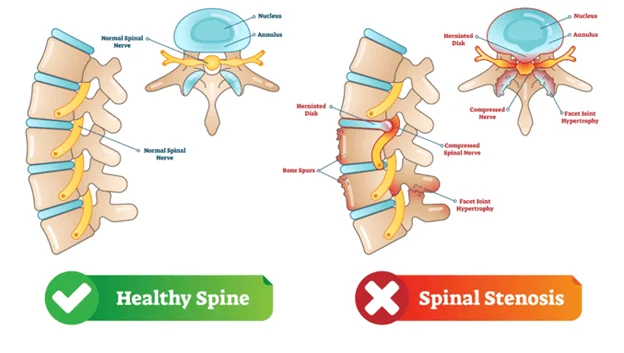Cervical spinal stenosis is a medical disorder defined by the constriction of the spinal canal in the cervical area, potentially resulting in the compression of the spinal cord and nerve roots. This constriction may arise from multiple degenerative alterations in the spine, especially as individuals advance in age. Cervical spinal stenosis can profoundly affect an individual’s quality of life, resulting in pain and functional impairments.
Symptoms of Cervical Spinal Stenosis
Cervical spinal stenosis symptoms can differ greatly from person to person based on the degree of compression of nerves and how severe the problem is. Common symptoms include:
- Neck Pain: Chronic neck pain is common and can spread to other areas of the body, including the arms and shoulders.
- Numbness and Tingling: Many individuals report sensations of numbness or tingling in their arms, hands, or fingers, often described as “pins and needles.”
- Balance Issues: Falls are more likely to occur for some people due to issues with balance and coordination.
- Bladder and Bowel Dysfunction: Control of one’s bladder and bowels may be compromised in extreme instances of cervical spinal stenosis.
Causes of Cervical Spinal Stenosis
Cervical spinal stenosis typically develops due to a combination of age-related changes and other factors:
- Degenerative Disc Disease: As discs between vertebrae age and lose hydration, they become thinner, contributing to narrowing.
- Osteophyte Formation: Bone spurs can develop as a result of arthritis, encroaching on the spinal canal and compressing nerves.
- Thickening of Ligaments: As time passes, the spinal ligaments may thicken, making the canal even more constricted.
- Herniated Discs: Discs that bulge or rupture can protrude into the spinal canal, exerting pressure on surrounding structures.
- Congenital Factors: Some individuals may have a naturally narrow spinal canal from birth, which can predispose them to stenosis.
Non-Surgical Treatment Options
For many patients with cervical spinal stenosis, non-surgical treatment options can provide effective relief from symptoms:
- Medications: Non-steroidal anti-inflammatory drugs (NSAIDs) are commonly prescribed to help relieve pain and minimize inflammation associated with nerve compression.
- Epidural Steroid Injections: For short-term pain and inflammatory treatment, these injections put corticosteroids into the epidural area around the injured nerves.
- Activity Modification: Patients are encouraged to avoid activities that exacerbate symptoms. Incorporating rest periods during daily activities can also help manage discomfort.
Surgical Treatment Approaches
If conservative treatment approaches fail to provide adequate relief or if symptoms significantly impair daily activities, surgical intervention may be necessary:
- Laminectomy: This ortho procedure removes a portion of the vertebra (the lamina) to relieve pressure on the spinal cord and nerves. It is one of the most common surgical treatments for cervical spinal stenosis.
- Foraminotomy: This surgery enlarges the openings where nerve roots exit the spine (foramina), relieving pressure on compressed nerves.
- Spinal Fusion: If decompression surgery leaves the spine unstable, spinal fusion can fuse two or more vertebrae.
Conclusion
If left untreated, cervical spinal stenosis is a substantial condition that can result in debilitating symptoms. To successfully manage this illness, it is vital to understand its causes, symptoms, and treatment choices. For individuals who do not get enough relief from conservative therapy, surgical interventions are an option; nevertheless, many patients do achieve relief without surgery. The quality of life and mobility of individuals affected by this condition can be significantly improved through early intervention.
For enquiries and online appointments:
Email – Naveen.st@gmail.com
Call/Whatsapp – +91 7676090119
Visit www.NaveenSpine.com to know more

